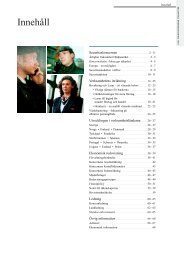SECURITAS AB Annual Report 2011
SECURITAS AB Annual Report 2011
SECURITAS AB Annual Report 2011
Create successful ePaper yourself
Turn your PDF publications into a flip-book with our unique Google optimized e-Paper software.
Volume-related factors<br />
The first two key figures, New sales (of contracts)<br />
and Net change (of contract portfolio), relate to<br />
the development of the customer contract portfolio.<br />
New sales are newly signed contracts that<br />
will increase the monthly fixed sales. Net change<br />
in the customer contract portfolio refers to new<br />
starts (a newly signed contract that has started)<br />
plus increased sales in existing contracts, less<br />
terminated customer contracts and reduced<br />
sales in existing contracts. Price changes are<br />
measured separately and added to Net change<br />
to determine the period’s closing balance of the<br />
contract portfolio. The closing balance is the<br />
total value of monthly invoicing on our monthly<br />
fixed contracts at the closing date for the current<br />
period.<br />
<strong>SECURITAS</strong>' MODEL FOR FINANCIAL KEY FIGURES<br />
Volume-related factors<br />
Efficiency-related factors<br />
The table below is an example illustrating the<br />
details of the contract portfolio:<br />
Value<br />
% change in<br />
opening portfolio<br />
Opening balance 100<br />
+ New starts 15<br />
+ Increases 5<br />
– Terminations -12<br />
– Reductions -4<br />
Net change 4 4<br />
Price change 3 3<br />
Closing balance 107 7<br />
The third key figure, taken from the statement of<br />
income, is Total sales, which in addition to contract-<br />
based sales, includes short-term assignments.<br />
Efficiency-related factors<br />
The efficiency-related key figures provide managers<br />
with tools to monitor service efficiency and<br />
cost trends. The fourth and fifth key figures are:<br />
Gross margin, which is defined as total sales less<br />
direct expenses as a percentage of total sales,<br />
and Indirect expenses, which pertain to the<br />
organization and include sales and administrative<br />
expenses (costs of branch, area and regional /<br />
country offices). Gross income less indirect<br />
expenses equals operating income before amortization<br />
of acquisition-related intangible assets and<br />
acquisition-related costs. When this is expressed<br />
as a percentage of total sales, it indicates the<br />
Group’s operating margin, which in Securitas’<br />
financial model, comes before acquisition-related<br />
items.<br />
Capital-usage-related factors<br />
In general, Securitas’ operations are not capitalintensive.<br />
Accounts receivable tie up the most<br />
capital. The sixth key figure is Days of sales outstanding<br />
(DSO). Payment terms and effective<br />
collection procedures are decisive in determining<br />
how much capital is tied up in accounts receivable.<br />
These figures are followed up on an ongoing<br />
basis at all levels in the organization.<br />
GROUP SECURITY SERVICES MOBILE AND MONITORING<br />
New sales<br />
Gross margin on new sales<br />
New sales / New starts<br />
Terminations<br />
Gross margin on terminations<br />
Terminations<br />
New / cancelled connections (Monitoring)<br />
Net change Net change<br />
Price change Price change<br />
Organic sales growth<br />
Acquired sales growth<br />
Real sales growth<br />
Organic sales growth Organic sales growth<br />
Total sales Total sales Total sales<br />
Employee turnover Employee turnover<br />
Wage cost increase Wage cost increase<br />
Prospects visited (Mobile)<br />
Cost per sale / order<br />
Average contract size (Mobile)<br />
Pay back time / duration<br />
Gross margin Gross margin<br />
Indirect expenses Indirect expenses<br />
Operating margin<br />
Income before tax<br />
Earnings per share<br />
Operating margin Operating margin<br />
Capital-usage-related factors<br />
Days of sales outstanding Days of sales outstanding<br />
Operating capital employed as % of sales Operating capital employed as % of sales Operating capital employed as % of sales<br />
Cash flow from operating activities as %<br />
of operating income before amortization<br />
Cash flow from operating activities as %<br />
of operating income before amortization<br />
Governance and management<br />
Management and financial control<br />
Cash flow from operating activities as %<br />
of operating income before amortization<br />
Free cash flow<br />
Return on capital employed Return on capital employed Return on capital employed<br />
Free cash flow in relation to net debt<br />
Securitas <strong>Annual</strong> <strong>Report</strong> <strong>2011</strong><br />
55

















